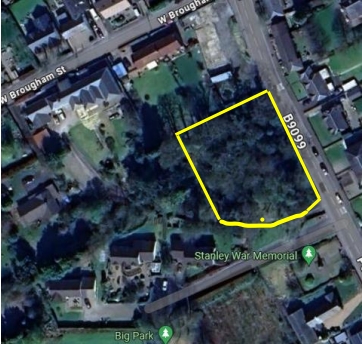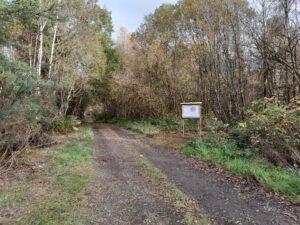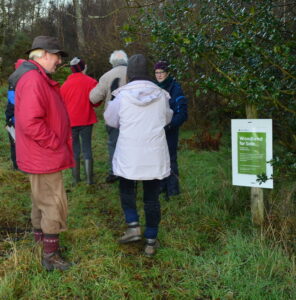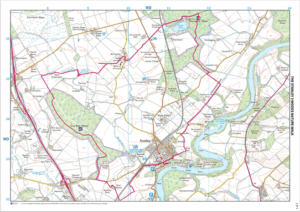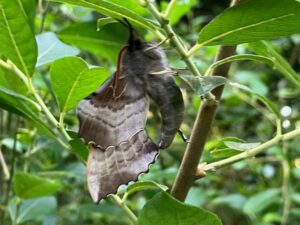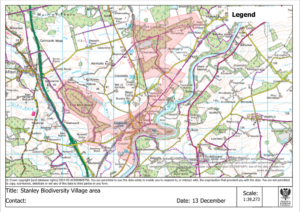Stanley Wildwood – why community ownership?
One of many participating communities across Perth and Kinross, Stanley has recently embarked on becoming a Biodiversity Village. In the Stanley Biodiversity Village Community Mapping Session in January 2024, Stanley Wildwood was identified by members of our community as a special habitat feature in the village. Indeed, also known as the Rookery, it is the Stanley “HQ” for the local corvid population which flocks there at dusk from numerous gathering points in mature trees elsewhere around the village. The 0.56 acre site has been under a Tree Preservation Order since 1987.
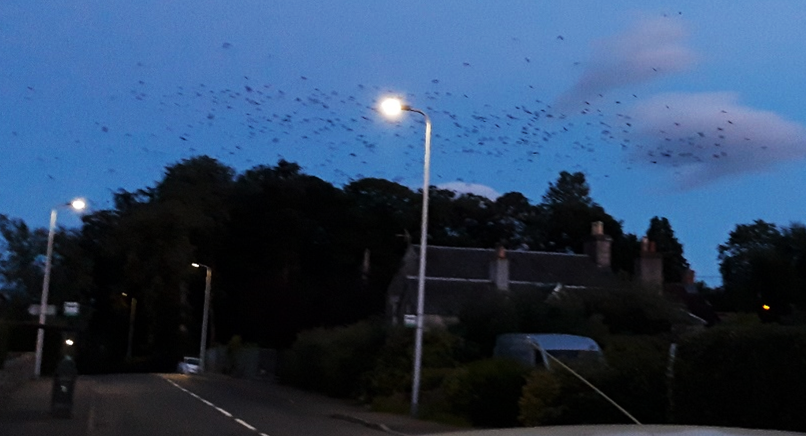
Rooks are colonial nesters, building their nests within a metre or two of their neighbours. Once established, these rookeries can be enduring; some are known to have been in use at the same site for over 100 years. The rook is a widespread and common bird, found all across the UK. It is a resident species that has however experienced population declines since about the year 2000, particularly in Wales and Scotland, and is now on the Amber list for conservation status meaning it is vulnerable. Decrease in brood size is now becoming evident. (Source: British Trust for Ornithology)
As well as being “Corvid HQ”, this rookery wood has valuable understorey vegetation for nesting, roosting and feeding habitat for birds, small mammals and other wildlife. Local residents have recorded and photographed diverse wildlife using the wood, including red squirrel, hedgehogs, bank voles, great spotted woodpecker, treecreepers and more. With management expressly for nature going forward, there is great scope to increase the species and numbers quite significantly. Through community ownership as part of the Stanley Biodiversity Village Project, the Wildwood could become the thriving and emblematic biodiversity heart of the village.
Rationale for community ownership or lease from PKC
Under knowledge-based management involving specialist local ecologists, the goal under community ownership would be to protect the existing biodiversity and enable the wood to meet its potential biodiversity value through enhancement and diversification of the habitat structure.
- Dual ecological and climate emergencies need action at local, national and global level in this UN Decade on Ecosystem Restoration.
- Scottish goal of stopping and reversing the decline of biodiversity by 2030.
- Scottish Government policy for increase in community ownership of land.
- Low disturbance as a priority for nature protection and recovery is fully compatible with the non-recreational status of the wood and privacy and preserving amenity for the owners of Wildwood House and other adjacent residential properties.
Main pros and cons of community vs private ownership
Pros – community ownership:
- The willing community groups (WSWG and TWP) have confirmed the prime purpose, if in their care on behalf of the local community, would be improvement of the management of the woodland for nature, in accordance with public safety and to the benefit of village amenity.
- Community wealth building.
- Democratically accountable and demonstrable commitment to management prioritising habitat protection, enhancement and biodiversity potential.
- Best guarantee of highest standards of environmental management in perpetuity.
- Best guarantee of high level of ecological and woodland management knowledge at heart of management process way exceeding minimum standards imposed by TPO status.
- Habitat and species monitoring as routine.
- Environmentally informed group approach more likely to seek minimum interventions (eg pruning rather than felling; safe deadwood retention; etc) within the regulatory framework of TPO for essential works such as disease management, tree-safe management, etc.
- If community groups disband, Constitutions will require site handed over to organisation with similar aims – safeguarding the site in perpetuity.
- Use for educational purposes in perpetuity.
- Community groups/charities able to access maintenance, restoration, biodiversity, educational and other grants.
- Retention of public access, albeit for environmental purposes rather than recreational purposes.
Cons – community ownership:
- No notable cons.
Pros – private ownership:
- The Enquiring Party has confirmed main personal goal is to reconnect Wildwood House and Wildwood but has advised that he would aspire to improve the management of the woodland if sold to him.
- Prospect of substantial personal financial gain. Acquisition at market value likely to add significant lifestyle premium to residential property value.
- Personal amenity gains.
- Potential use for educational purposes.
Cons – private ownership:
- Management dependent on knowledge and commitment of individual property owner at any given time.
- There is no guarantee how long the Enquiring Party would retain possession of the property.
- TPO guarantees only minimum legal standards of environmental management.
- Risk of individual owner greater than community owner to pursue felling as most appropriate intervention within the regulatory framework of TPO for essential works such as disease management, tree-safe management, etc.
- Loss of public access.
- Ability of private owner to exclude access at will. No means of site monitoring other than by goodwill or access for enforcement reasons.
- If property is sold on, no guarantee subsequent owners will exceed minimum legal standards of environmental management.
- Funding likely to be entirely dependent on resources of householder at that time.
WSWG and Tayside Woodland Partnerships therefore believe the best way by far for safeguarding the Wildwood in perpetuity, protecting and enhancing its biodiversity value for the rooks, jackdaws and many other plant and animal species in future, is for it to be transferred to a community group whose sole purpose is manage it to be the best it can be for nature. We see this highly visible and much-loved woodland at the heart of the village as a Flagship Project for nature and learning in the Stanley Biodiversity Village initiative.
If you live in Stanley and District (including Airntully, West Tofts, Taymount, Kinclaven and the Gowrie Straight) and agree with us, please take part in the on-line consultation and vote for Option 2: “The Council should explore the willingness of any suitable community groups for taking on responsibility for managing the woodland site under a lease or sale.”
Voting closes 11 August 2024. Thank you so much for your support for a thriving local environment.
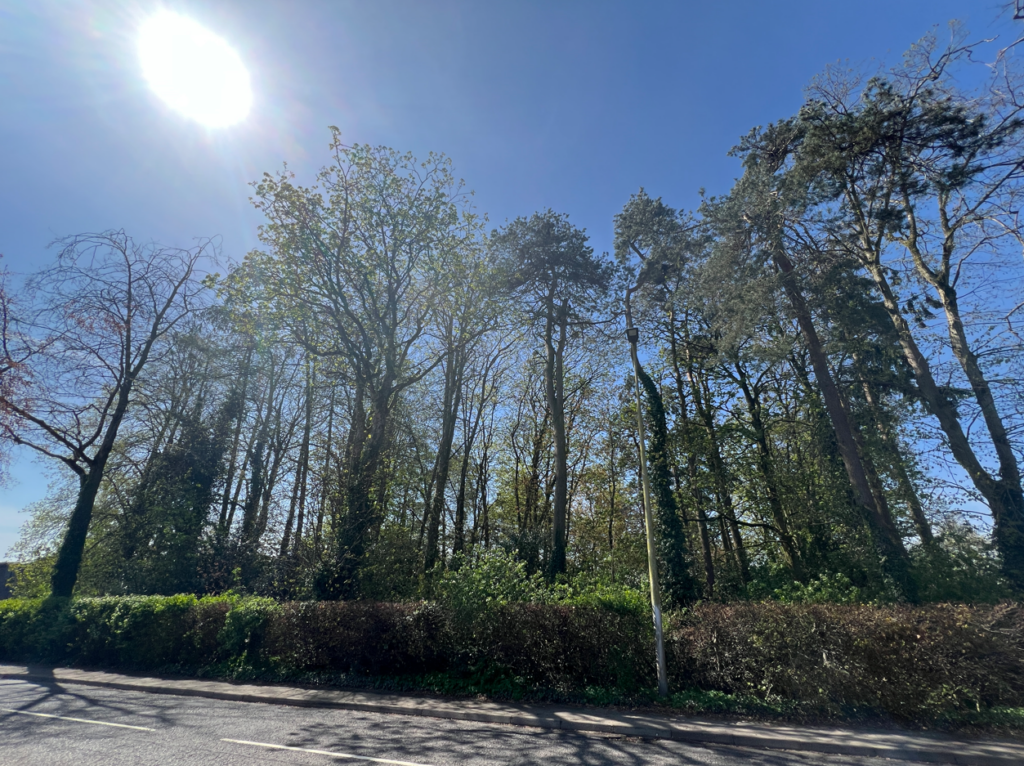
Working together for our local communities and environment
Tayside Woodland Partnerships (TWP) is a Scottish Charitable Incorporated Organisation with the objective of establishing and maintaining woodlands in Tayside for habitat restoration and sequestering carbon as a contribution to the Scottish Government’s target to achieve zero net emissions, and to play a part in addressing the climate and nature emergency. www.taysidewoodlandpartnerships.org
WSWG and TWP are working together on finding the optimum approach for community ownership or leasing of Stanley Wildwood.

